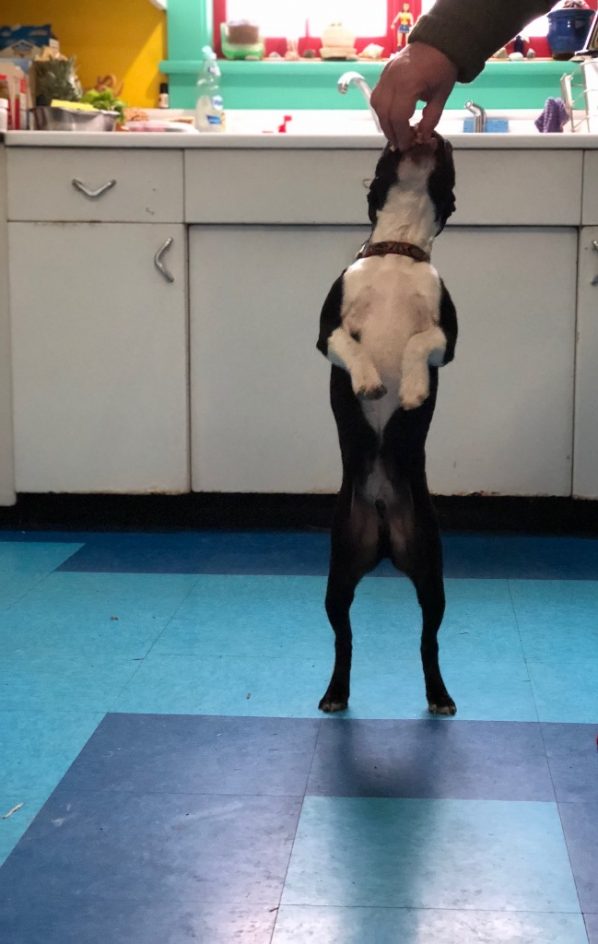
Gus has now eaten his food three days in a row with no regurgitation, vomiting or gagging. As many of you know, he was diagnosed last week with Megaesophagus, a nasty serious illness caused by a swollen esophagus that blocks food and prevents it from entering the digestive system.
Until recently, megaesophagus was considered a certain death sentence, but as we learn about the disease, there are now recommended stops that can work. It is uncertain whether Gus will get worse or stay the same. We’ll just have to see.
So far, so good.
Dogs can choke, starve or die from the illness, or also contract pneumonia. We changed quite a bit of Gus’s eating happens. We’ve switched to gastroenteric canned dog food, hold Gus upright in our laps after eating, and I’ve trained him to stand up on his hind legs and eat his food one meatball-style chunk at a time.
He would make a great circus dog, he loves to stand up and swallow standing up, and is fun for both of us. This is the same position he would be eating in if he sat in one of the custom-made Bailey Chairs people use with dogs who have this issue.
This kind of illness raises ethical questions for me in terms of money, perspective and quality of life – for dog and human. I do not generally believe that dogs who cannot live their natural lives should be kept alive by any means and all costs.
Since the dog can’t tell us what he or she wants, I feel we have to be their advocates, and as I wouldn’t urge a person to prolong their lives unnaturally – I see the results of that all the time – I wouldn’t want to do it to a dependent dog that can’t tell us their wishes.
I don’t think it’s humane or morally justifiable in a world so many people need help desperately. So we have to find a way to keep Gus healthy and active without sacrificing the quality of our lives or his. We will work very hard at it.
I see many people lose all perspective when a dog is chronically, spending money they don’t have and subject the animal to endless misery and confusion. The money we spend is not the only measure of love.
It is always a personal and individual decision, and I don’t tell anyone else what to do. Vets tell me that is the hardest thing for them to see.
Dogs are not about that for me, they improve our quality of life and we improve theirs.
We have already tried a dozen things, and are finding some that work.
With this method of standing him up, and getting him to eat standing up. we enlist gravity to help us get the food down where it ought to be and through the enlarged esophagus. Same thing with holding him upright after meals, it gets the food moving down.
I feel like we are getting on top of this. In the past week, he’s spit up his food three times, a drastic reduction from the previous week. In the past three days he hasn’t regurgitated any food at all.
Maegesophagus is a mystery disease, it is not related to breeding, and there is no medical cure. No one really knows the case, none of the dogs in Gus’s family or line have it.
I think the switch in food has helped, we are also cutting back on Gus’s time in the pasture, where he scarfs up all kinds of food and revolting things. Sometimes this disease gets worse, sometimes it just goes away. I also give him Pepcid once or twice a day in chewable tablets.
I’ve read through many of the online forums and studies of this disease, but the most helpful things have been trial and error, experimentation, a good vet and patience.
After the first week of treatment, I feel very optimistic about it. Gus is not losing weight, he is eliminating normally, has a strong appetite, plenty of energy and seems very active and healthy. He is an adaptable, trainable dog who is easy-going and forgiving, even when we squirt antacid medicine down his threat.
This is a strong report for the first week, we have made real progress, and I am happy to have avoided a Bailey Chair. I think we’ll work around that.
But the vets say this is a “dread” condition, and we will need more time to understand it. I’ll share the trip.
